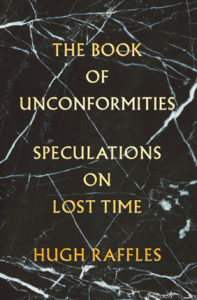
A long sentence careens through Hugh Raffles’s The Book of Unconformities: Speculations on Lost Time. At 458 words, the sentence zigzags from a description of a helicopter ride gone wrong over Greenland to the cornucopia of consumer offerings at U.S. military bases to CNN’s coverage of the shootings at Marjory Stoneman Douglas High School to a history of Inughuit settlements at Qaanaaq, Savissivik, to prohibitively expensive internet data packages to, finally, the expulsion of Inughuits from the area that is now a U.S. base. Raffles includes extravagant digressions like this in all six chapters of his recently published book, each named for a kind of stone: marble, sandstone, gneiss, magnetite, blubberstone, and iron. A surprisingly brief epilogue connecting his family’s Holocaust history to mica is titled “Muscovite.”
Some readers will grow peevish when repeatedly served heaping, indigestible helpings of words, viz., a description of ancient monoliths in the Outer Hebrides that “started life not as muddy deposits in warm, shallow seas, accreting grain by grain and organism by organism, but as churning magma dozens of miles underground in the Earth’s mantle, cooling, solidifying, and crystallizing into igneous granites, granodiorites, tonalites, basalts, and gabbros, then buried, reheated, sheared, and recrystallized, crushed, twisted, stretched, pressed, and folded in at least two major metamorphic, mountain-building events over the next 1.5 billion years….” No, reader, this is not the end of the sentence, which goes on and on, gerund upon gerund, stretching over what might seem like geologic time.

Other readers, though, may welcome Raffles’s encyclopedic, antiquarian bent. He is a professor of anthropology at the New School for Social Research, where he heads the Graduate Institute for Design, Ethnography, and Social Thought. In previous publications, he has developed a multidisciplinary, associative style, allowing him to explore connections between most anything he finds relevant and interesting, whether it’s the Amazon, insects, or — in this most recent publication — rocks. He includes black-and-white maps, archival documents, and photographs (many of which he took himself) throughout this wide-ranging example of humanities scholarship with popular appeal.
An “unconformity,” Raffles explains in his introduction, is a term geologists use to describe “a discontinuity in the deposition of sediment,” the “material sign of a break in time,” “both a seam and a rupture.” He employs the concept to explain the grief he feels as he contemplates two of his sisters’ deaths, which occurred within weeks of each other 25 years ago, dropping a few details of his sisters and their deaths into his chapters. But his feelings are so elusive — and his style so allusive — that he fails to conjure them as meaningful characters. He writes that he reached for stones as he tried to reckon with his losses, but the connection mostly seems tenuous between these long-missing sisters and the many other characters who are central to the book.
It is those characters and their histories that provide Raffles a different kind of “unconformity” to study. His people engage in global dynamics he identifies as imperialism, industrial capitalism, genocide, environmental exploitation, and cultural hegemony. They include well-known figures such as Henry Hudson and Robert E. Peary, as well as those whom history has obscured — for example, Naomie Kennedy, who was said to be a Cherokee princess and lived for a time in Manhattan’s Inwood Hill Park, and Peary’s black assistant, Matthew Henson, who, like Peary, fathered children whose descendants live in Greenland.
The rocks themselves may show signs of geological “unconformity,” but it is their relationship to a variety of human-made ruptures and seams that interest Raffles, and that often fascinated me. “Blubberstone,” for example, isn’t just a description of a geological fact. It is a product of 17th-century whaling in the Svalbard archipelago, which led to the decimation of reindeer, eider ducks, walruses, seals, and foxes. Similarly, “Magnetite” — my favorite (and the shortest) chapter — finds Raffles in western Iceland to check out volcanic rock that is seemingly capable of derailing navigational devices: “It’s midwinter, zero degrees, a few hours of velvet light each day. Thick slabs of blue-green ice wheeze and crack on the frozen pond that reaches deep into the moss-covered lava field. Keening kittiwakes skim the North Atlantic. And something else: the Grimsby trawler Epine, lost in a blizzard and Force 9 gale.” Here, Raffles writes in relatively direct sentences, his words transporting me on a physical journey made impossible by the pandemic. In such moments, I could not have wished for a more welcome travel guide.
At its best, Unconformities reminded me of Bruce Chatwin’s semi-fictional exploration of indigenous Australian Dreamings in The Songlines. It also brought to mind Edmund de Waal’s history of porcelain, The White Road: Journey Into an Obsession. In each of these works, curious, smart writers gave themselves permission to explore and learn and connect. At its worst, Raffles’s book recalled the densest, least immediately rewarding parts of Moby-Dick.
I was glad Raffles included a quote from Pliny the Elder, a Roman who remarked in his Natural History that rocks have a voice, and this voice “interrupts that of Man.” “Pliny liked to meander,” Raffles notes, and his great work, acknowledged to be the prototype of the encyclopedia, “is full of erudite digressions, insatiable curiosity.” The Book of Unconformities awaits patient readers who are open to Raffles’s own erudition and digressions, both of which, for better and worse, are considerable.
